Pile Driving and Its Versatility Across Industries
29th November 2023

Pile driving is a fundamental construction technique that plays a crucial role in supporting structures and foundations. It involves the installation of piles, which are long, slender columns typically made of steel, concrete, or wood, into the ground to provide stability and support for various types of structures. This technique has been employed for centuries and remains a cornerstone in construction and civil engineering projects worldwide. It has many diverse applications across different industries, but what is pile driving?
The Basics of Pile Driving
Pile driving is a method used to embed piles into the ground to create a stable foundation for structures such as buildings, bridges, and offshore platforms. The process typically involves the use of a pile driver, a specialised machine designed to lift and drop a heavy weight (the hammer) onto the head of the pile, driving it into the ground. The impact of the hammer transfers energy to the pile, allowing it to penetrate the soil or bedrock.
Types of Piles
Various types of piles are used in pile driving, each selected based on the specific soil conditions and structural requirements of the project. Common types include:
Concrete Piles
Made of reinforced concrete, these piles are durable and suitable for a wide range of soil conditions.
Steel Piles
These piles are often used in marine environments or where high strength and corrosion resistance are required.
Timber Piles
Typically used in coastal and waterfront structures, timber piles are cost-effective and offer good load-bearing capacity.
Composite Piles
Comprising a combination of materials, such as steel and concrete, composite piles are designed to capitalise on the strengths of each material.
Applications in Various Industries:
Construction Industry
Pile driving is extensively used in the construction of buildings, bridges, and other infrastructure projects. It provides a solid foundation by transferring the load of the structure to deeper, more stable soil layers, preventing settling and ensuring structural integrity.
Marine and Offshore Industry
In marine and offshore applications, pile driving is essential for constructing foundations for piers, docks, and oil platforms. Steel or concrete piles are commonly used to withstand the harsh conditions of saltwater environments.
Transportation Sector
Pile driving is employed in the construction of bridges and overpasses to create stable foundations that can support the weight of heavy traffic. This ensures the longevity and safety of transportation infrastructure.
Renewable Energy Projects
Wind farms and solar installations often require deep foundations to support the weight and vibrations of turbines and solar panels. Pile driving is instrumental in creating stable foundations for these renewable energy structures.
Civil Engineering and Infrastructure
Pile driving is widely used in the construction of retaining walls, sound barriers, and other civil engineering structures. It provides stability in areas with challenging soil conditions.
Pile driving stands as a testament to the ingenuity of construction and engineering disciplines, providing a robust solution for creating stable foundations in diverse environments. Its applications across various industries showcase its adaptability and importance in ensuring the durability and safety of structures worldwide. As technology continues to advance, pile driving techniques are likely to evolve, further enhancing their efficiency and sustainability in construction practices.
Palfinger UK are one of the top suppliers of pile driving equipment in the country, and are the sole distributor of Orteco lorry and crawler mounted pile drivers. To find out more, visit our pile driving page today.
